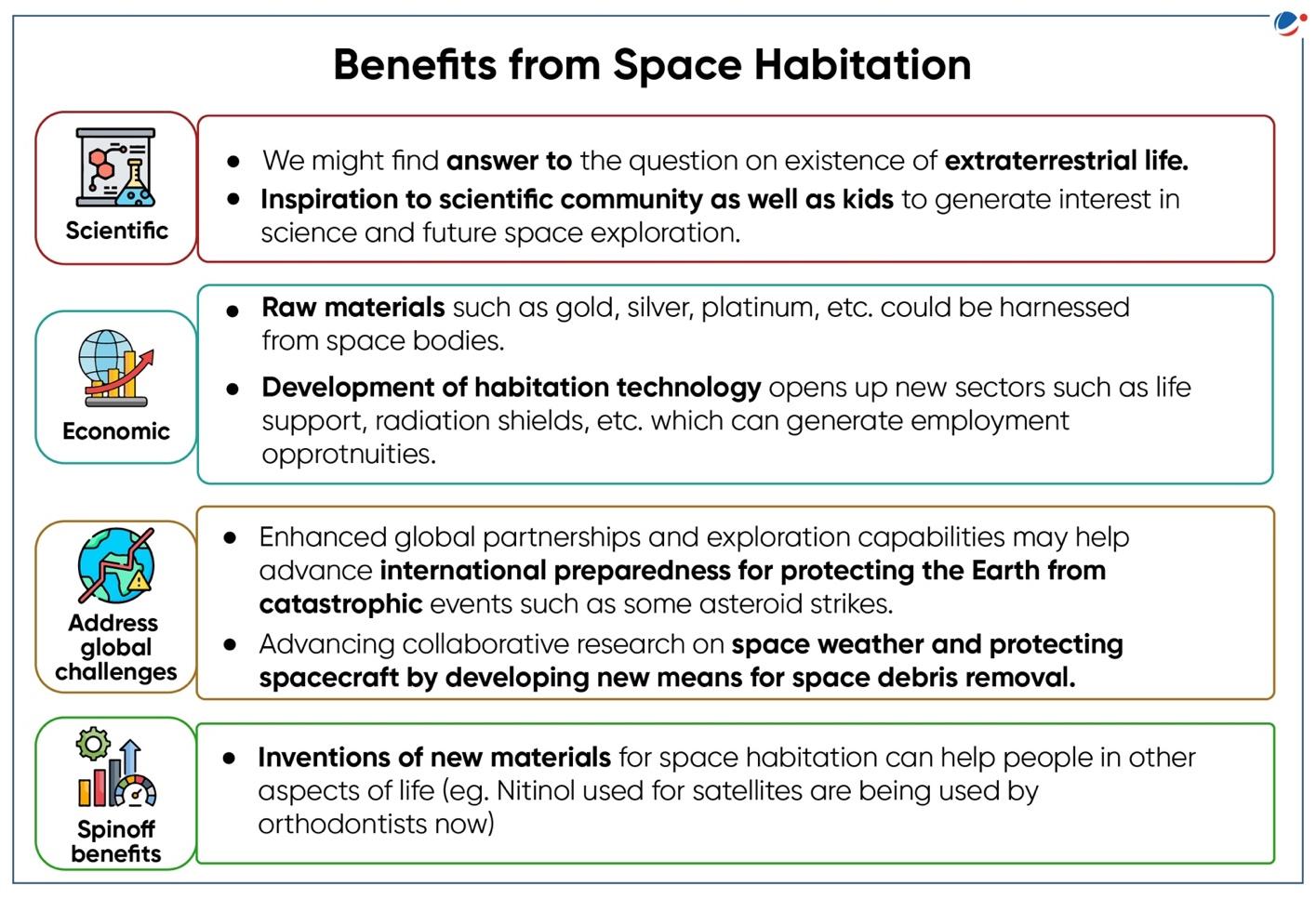Why in the news?
NASA’s plans to create homes and habitable colonies on the moon by 2040 have opened up the debate about the habitation of the moon as well as other heavenly bodies.

About space habitation
- Space habitation refers to setting up of habitation for humans beyond earth such as on Moon, Mars etc.
- It could be done in two ways:
- Habitation of the celestial bodies such as mars which come in the goldilocks zones.
- Building space habitats in form of capsule modules which can be located anywhere in the solar system. For example: International Space Station
- Stanford Torus and O’Neill Cylinder have been proposed as self-sustaining habitats in space which can support agriculture and various activities in a microgravity environment.
- Stanford Torus proposed by NASA envisions a toroidal (doughnut-shaped) space station with a central hub and a rotating outer ring.
- The rotation would create artificial gravity on the inner surface of the ring, allowing for human habitation.
- O'Neill Cylinder, named after physicist Gerard K. O'Neill, consists of a pair of large cylinders rotating in opposite directions to create artificial gravity on their inner surfaces.
- Stanford Torus proposed by NASA envisions a toroidal (doughnut-shaped) space station with a central hub and a rotating outer ring.
- Different countries such as USA, China, and India have been taking initiatives to send their astronauts to moon and to explore the possibilities of space habitation.
- Additionally, private space entrepreneurs such as Elon Musk has expressed his desire of building and supporting a permanent human settlement on Mars.

Issues associated with the space habitations
- Enormous Costs: The development of essential technology and infrastructure for space exploration incurs significant costs.
- Additionally, the extended gestation period of such technology adds to the financial burden.
- Execution: Managing oxygen, food, medical supplies, power sources, communications, and transportation to and from Earth poses technical and operational challenges.
- Health Implications: Cosmic radiation, lack of a breathable atmosphere, reduced gravity, isolation, and psychological stress pose health risks to inhabitants.
- Environmental Modification: Altering other planets' environments may harm their landscapes and contribute to space debris, with a possibility of triggering the Kessler syndrome.
- The Kessler syndrome envisions a situation where a single collision between two space objects generates debris, and this debris, in turn, increases the likelihood of further collisions.
- Legal and Political: It includes issues regarding the ownership of resources, governance, and regulation of space activities.
- Ethical issues: Potential damage to the intrinsic value of alien planets raises ethical concerns.
Way ahead
- Resource Utilization: Reduce Exploration Costs by relying on space resources rather than launching everything from Earth.
- Technological development: Develop advanced technologies for mining and processing space resources.
- For example, robots designed to scoop icy soil on the Moon, and machines that are capable of thermally extracting water from the clay minerals of planets.
- Ownership of Habitable Planets: Global collaboration is needed to devise legal framework to address questions of territorial claims and private property if a country or company makes a planet habitable.
- Ethical Considerations: Engage in ethical discussions around space habitation, addressing issues of commons rights, risk burden, and justice.
- Collaborative approach: Global collaboration and sharing of knowledge and best practices among stakeholders is also critical to expand the reach of humanity in the space.
- This collaboration should align with international treaties established by the United Nations Committee on the Peaceful Uses of Outer Space (UNCOPUOS).
International treaties under UNCOPUOS for governing Outer Space
|
Conclusion
For space habitation, humans should adhere to the trusteeship principle, taking responsibility for the well-being of non-human animals and the environment, both on Earth and beyond, including in space.








